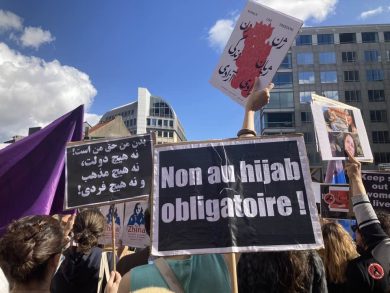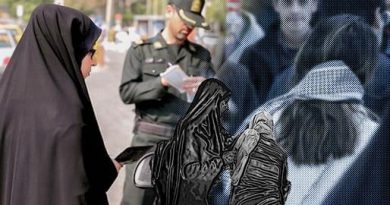In a nation where speaking up often means risking your life, Iranian feminists have chosen courage over silence. Their bravery, in the face of decades of systemic oppression, has not only challenged the regime’s power but also ignited a global movement for women’s rights and freedom. These women—writers, lawyers, journalists, mothers, students—have become symbols of resistance, refusing to yield to the fear imposed by the Islamic Republic and its powerful arm of repression, the Islamic Revolutionary Guard Corps (IRGC).
The slogan “Women, Life, Freedom”, which emerged as the rallying cry after the death of Mahsa Jina Amini in 2022, has become much more than a chant. It is a manifesto of a new generation of Iranian feminists who are breaking the chains of silence, control, and fear. In this analysis, we explore the historical roots, current leaders, and the ongoing struggle of Iranian feminists, and how they continue to reshape Iran’s political and cultural landscape—despite facing prison, torture, and exile.
1. The Historical Roots of Feminist Resistance in Iran
A. Pre-Revolutionary Feminism
Iranian women’s struggle for equality is not a recent development. Even before the 1979 Islamic Revolution, Iranian feminists were pushing for reforms in education, marriage laws, and political participation. Women gained the right to vote in 1963 and played significant roles in shaping civil society.
B. Post-Revolution Suppression
The Islamic Revolution marked a turning point. In the new Islamic Republic, women’s rights were rolled back:
• Mandatory hijab laws were enforced.
• Family laws reverted to patriarchal norms.
• Women were barred from judicial positions and many fields of study.
Despite this, feminist activism adapted—often underground or through cultural resistance—and persisted in small but significant ways, eventually evolving into a bolder, public movement.
2. The Modern Faces of Iranian Feminism
A. Narges Mohammadi – The Voice from Prison
A journalist and human rights activist, Narges Mohammadi has spent years in prison for:
• Protesting the death penalty.
• Advocating for women’s rights.
• Documenting torture and abuse in prisons.
Despite her imprisonment, she was awarded the Nobel Peace Prize in 2023, highlighting how her voice resonates beyond the prison walls.
“Even if I’m behind bars, I’m not silenced,” she once wrote from her cell.
B. Masih Alinejad – The Exiled Disruptor
From exile, journalist and activist Masih Alinejad launched the #MyStealthyFreedom and #WhiteWednesdays campaigns, encouraging women to remove their hijabs and protest compulsory dress codes.
Her digital activism:
• Exposed the IRGC’s surveillance.
• Empowered countless women to share their stories.
• Drew international attention, leading to assassination and kidnapping plots against her.
C. Nasrin Sotoudeh – The Human Rights Defender
Nasrin is a lawyer known for defending women arrested for removing their hijabs. She’s been repeatedly:
• Jailed.
• Beaten.
• Banned from practicing law.
She symbolizes resilience in the face of institutional misogyny and is a pillar of legal feminist advocacy.
3. The Role of the IRGC in Silencing Feminist Voices
A. Arrest and Intimidation
The IRGC routinely arrests feminist leaders, especially those:
• Attending or organizing protests.
• Sharing critical content online.
• Publishing articles or academic work on gender rights.
B. Torture and Forced Confessions
Women in IRGC-controlled prisons face:
• Psychological torture.
• Sexual harassment.
• Forced confessions aired on state TV.
These tactics are meant to shame and silence, but many women continue to resist even from solitary confinement.
4. Feminist Tactics: Resistance in Many Forms
A. Cultural Resistance
Iranian feminists use:
• Poetry, art, and literature.
• Documentaries and underground films.
• Fashion as protest, like showing hair in defiance of hijab laws.
B. Legal Challenges
Many feminists file legal cases challenging:
• Guardianship laws.
• Divorce and custody inequalities.
• Discrimination in hiring and education.
C. Online Activism
Digital campaigns like:
• #WomenLifeFreedom
• #FreeIranianWomen
• #EndHijabLaws
…have become powerful tools in mobilizing international support and bypassing state-controlled media.
5. The Power of Solidarity: Feminists Are Not Alone
Iranian feminists have found global allies, including:
• International human rights organizations (e.g., Amnesty International, Human Rights Watch).
• Diaspora communities organizing protests in Berlin, Paris, London, Toronto, and New York.
• Celebrities and politicians amplifying their stories and calling for sanctions against abusers.
This solidarity helps:
• Protect activists under threat.
• Pressure foreign governments to act.
• Keep the spotlight on gender apartheid in Iran.
6. Feminism and the Broader Fight for Democracy
Iranian feminists emphasize that:
• Women’s rights are human rights.
• Without gender equality, there can be no true democracy.
• Fighting for bodily autonomy and freedom of choice is inseparable from the wider call for regime change or reform.
Their leadership is not secondary—it is central to Iran’s democratic future.
7. Challenges Ahead
Despite global support, Iranian feminists face enormous risks:
• Increased surveillance and censorship.
• Legal threats against families and children.
• Disinformation campaigns to discredit them.
But they continue to adapt, creating networks of solidarity that cross ethnic, religious, and class lines—a united front that terrifies the regime.
Conclusion: Feminism Is Iran’s Future
The Iranian feminist movement is not only a challenge to theocratic oppression—it is a visionary force for a better future. These women refuse to be silent, even when the cost is their freedom or lives. They are the authors of Iran’s future, and the world must listen, support, and act.
Join Our Newsletter!
Stay informed with the latest updates, news, and ways to take action in the fight for justice and global security. Sign up now to get updates delivered straight to your inbox!





